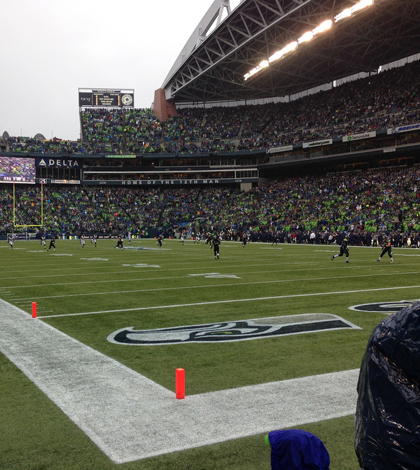Seismographs at NFC championship to track Beast Quakes, prep scientists for real tremors

Seattle Seahawks game at CenturyLink Field (Credit: erocsid, via Flickr)
The Seattle Seahawks’ stadium has been called the loudest in the National Football League, known especially for the “Beast Quake” that shook the structure during a Marshawn Lynch touchdown run in the 2011 playoffs. Though that title has been contested recently by fans at the Kansas City Chiefs’ Arrowhead Stadium, there is one distinction no other stadium in the league can touch. Installed on the lower and upper decks of the Seahawks’ house are seismographs to monitor the vibrations fans make when big plays happen on the field.
The installations, supported by the Pacific Northwest Seismic Network housed at the University of Washington, don’t really yield scientifically important data. Instead, they provide scientists at the network with an opportunity to hone deployment skills and test new seismic tech, while giving fans something neat to check out during Seahawk games. The seismic readings are also the subject of sportscaster discussions on television and whip up attention on social media during play.
This year is the second that the seismographs will be in place during the NFL playoffs.
“Last year, we thought we would exercise our seismographs,” said Bill Steele, communications director for the Pacific Northwest Seismic Network. “We took three and installed one at the field level and two on the upper levels and we saw how we could take the data and upload it to our site as practice.”
There were some issues meeting demand for the seismic data that time around, says Steele, as hundreds of thousands of fans flocked to the website to see so-called “beast quakes” in nearly real time. The quakes are termed after running back Lynch, who goes into what he calls “beast mode” as he powers his way through defenders to score touchdowns.

The seismograph captured during Marshawn Lynch’s original “Beast Quake” run on Jan. 8, 2011. (Credit: Pacific Northwest Seismic Network)
But the network has teamed up with Microsoft Azure this year to enhance its website for more traffic. The time ratio between seismic data posting and the typical television delay has also gotten better, with latency dropping from 10 seconds to three seconds. This means that fans tracking the seismic charts online can see spikes about five seconds before big plays are shown on TV.
This year is also providing seismologists with a chance to test out new strong motion seismometers, in addition to allowing continued work for smoothing out data transmission that helps other earthquake monitoring efforts the network oversees.
“We’re developing an early warning system with UC Berkeley and one challenge is to reduce latency,” said Steele. “So by pushing out data within seconds of quakes (on the field), part of that ability is to reduce latency, but it’s also fun.”
Clearly the effort helps encourage interest in earthquakes, volcanoes and other seismic hazards, something that the PNSN tries to address through public outreach. The social media aspect of the project — seismologists live tweet graphs generated from in-game data and blog about findings on the network’s website — is letting researchers learn what sort of informational tools the general public needs to best spread awareness of seismic warnings.

The QuickShake tool’s signal of Kam Chancellor’s 90-yard interception return against the Panthers on Jan. 11 (Credit: Pacific Northwest Seismic Network)
Tools like the QuickShake, which pushes seismic waveform data to web browsers in near real time, is one application being run through its paces. By seeing how the tool works for real-time data sharing with Seattle Seahawks fans, researchers can estimate what sort of capabilities are needed to scale it up and meet needs for alerting the general public if larger seismic events occur.
The last go-around for researchers in 2015 will be the National Football Conference championship game, taking place January 18 between the Green Bay Packers and Seahawks. Fans can follow along at pnsn.org/seahawks, on Facebook and on Twitter.
“We’ll have three of our technicians at the game to make sure things are in working order, and they’ll be tweeting personally,” said Steele.
Top image: Seattle Seahawks game at CenturyLink Field (Credit: erocsid, via Flickr)




0 comments